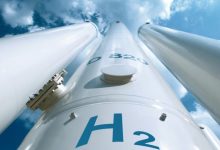Hydrogen production could become a lifeline for wind and solar projects facing curtailment due to network infrastructure constraints, by tapping into otherwise forgone electricity generation to power electrolysers.
A growing number of renewable energy projects are being forced to cut output, both in Australia and overseas, as network and storage infrastructure – as well as market rule adjustments – lags behind the growth in new wind and solar projects.
But the ‘over building’ of wind and solar capacity could become a blessing, with the growing viability of using surplus electricity to produce zero emissions and cost competitive hydrogen.
The argument for producing hydrogen from the electricity that would otherwise be curtailed has been put forward by Gniewomir Flis, a senior analyst with UK based Aurora Energy Research and who previously worked under BloombergNEF founder Michael Liebreich.
Flis turned to Twitter to argue that, provided an electrolysis unit could be acquired at a sufficiently attractive price, it could be possible to produce hydrogen using electricity that would otherwise be foregone due to curtailment.
To become cost competitive with hydrogen produced from fossil fuels, the challenge is to build electrolysers at a sufficiently low cost. Flis cited research showing that there have been dramatic cost reductions as the global market for electrolysers grows.
If you’re getting curtailment only from one source or the other, and purchased your electrolyser at $450/kW CAPEX, can just about produce H2 at $2/kg.
Congratulations, you can now compete with fossil fuel H2, and upset the status quo for ammonia and petrochemical markets. pic.twitter.com/Est3cnw5vq
— Gniewomir Flis (@gnievchenko) February 18, 2020
Liebreich has argued that the curtailment of renewables is not as big a concern as it may seem on the surface. Due to the dramatic falls in costs, new wind and solar projects would still be able to outcompete new fossil fuel projects on cost even with significant levels of curtailment.
“Think about it: if your $20/MWh wind or solar suffers 33% curtailment, you know what happens? It turns into $30/MWh wind or solar – still half the price of power from any other source,” Liebreich said.
Analysis prepared by global consultancy McKinsey for the world Hydrogen Council found that with sufficient investment, renewable hydrogen could become cost competitive with unabated fossil fuel hydrogen within the next ten years.
The argument is similar to that made by CEO of the Australian Renewable Energy Agency, who suggested last year that Australia could aim for as much as 700 per cent renewable electricity, using the excess to produce cheap, emissions free, hydrogen for export.
Hydrogen production provides a type of ‘flexible demand’ that can be a good match with the variable nature of wind and solar generation. It creates the potential for a country like Australia, with abundant solar and wind resources, to ‘over build’ its renewable generation capacity, and use the surplus electricity to produce zero emission hydrogen.
Several energy regulators, including chair of the Energy Security Board, have argued that a future energy system will require both flexible supplies and demand.
Parts of Australia are already battling with infrastructure issues that have necessitated the curtailment of wind and solar projects.
Several renewable energy projects in Western Victoria have been forced to cut output by as much as 50 per cent, while regulators and network companies attempt to resolve constraints within transmission networks.
The value of this curtailed electricity output could be captured with the inclusion of an electrolyser producing hydrogen, which allows the energy to be stored and then used as needed.
There are a growing number of proposals to deliberately ‘overbuild’ electricity generation capacity in parts of Australia, including a proposal to build as much as 5,000MW of solar and wind capacity in Western Australia, with the intention of using surplus electricity to produce and export hydrogen.
Australia’s chief scientist, Dr Alan Finkel, who developed the National Hydrogen Strategy, has advocated for producing hydrogen using fossil fuels paired with carbon storage, at least until the cost of producing hydrogen using renewable electricity falls.
The chief scientist has also argued that it would be beneficial for Australia to identify ways to continue utilising its fossil fuel reserves, while also reducing emissions, as it would provide greater diversity of energy supplies.










